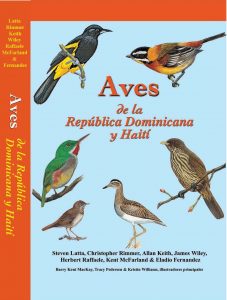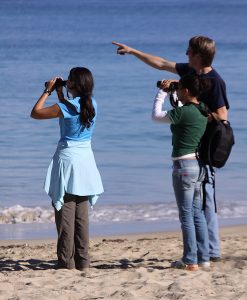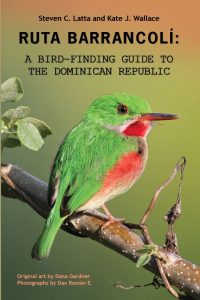Bird Friendly Cacao: Industry-leading effort to promote cacao-growing practices that benefit birds
We’ve all heard of bird-friendly coffee; but what about bird-friendly chocolate? The Dominican Republic boasts 60 percent of the global market share of organic cocoa, which is produced on over 40,000 cacao farms. At the National Aviary, we have organized the first Bird Friendly Cacao Initiative to promote cacao-growing practices that benefit birds!
On Hispaniola, as in much of Latin America, shade-grown and wildlife-friendly coffee farming has been promoted for the conservation of Neotropical migratory birds and threatened endemic species, with market-oriented coffee certification programs used to conserve biodiversity and benefit growers. But, no such programs exist for cacao growers.
Cacao farms are also capable of supporting a high level of biodiversity. Based on studies by the National Aviary’s Research Associate, Andrea Thomen, we launched our own Bird Friendly Cacao Initiative in 2015. Our surveys found cacao agroforestry benefits a wide variety of endemic birds and overwintering Neotropical migrants, but also showed that cacao technicians and community educators needed to encourage shade diversification in cacao plantations, and the restoration of native shrub cover in riparian areas.
Importantly, we also assessed farmer attitudes and behavior towards within-farm fauna and wildlife-friendly management practices, and determined farmer behavioral attitudes regarding bird-friendly agroforestry practices. We found that challenges in improving habitat for birds in cacao plantation may arise due to farmer’s negative attitudes towards woodpeckers, in particular, because woodpeckers sometimes damage cacao pods. In addition, raptors were widely viewed negatively because it is feared they ate chickens and other livestock.
The National Aviary has also worked with Dominican collaborators in outreach and education efforts to promote avian conservation in the cacao industry. In collaboration with Grupo Acción Ecológica, we presented a Technician Environmental Education Workshop to the agronomists who are responsible for certifying organic cacao production, and who provide technical advice to growers, and supervise and enforce rules related to organic certification.
Our workshop educated these technicians on criteria that support Bird Friendly Cacao. Through presentations and field experience, we encouraged biodiversity conservation in cacao farms. Our work helped technicians understand bird-mediated ecosystem services, the importance of riparian zones for the conservation of herpetofauna, the role of wildlife in insect control, the value of endangered endemic owls and hawks in rat control, and the importance of diverse vegetation communities in cacao plantations to support ecosystem services as well as timber, cash crops and medicinal needs.
Field Guides Open Doors

The National Aviary’s Director of Conservation and Field Research, Dr. Steven Latta, is the primary author of the first comprehensive field guide to the birds of the Dominican Republic and Haiti, available in English, Spanish, and French. By increasing interest in birds, birdwatching helps to create gateways to conservation, promotes ecotourism, and builds local support for preserving natural resources.
Hispaniola is a natural destination for birdwatching. Shared by the Dominican Republic and Haiti, Hispaniola supports a remarkably diverse avifauna of at least 310 species—more than any other Caribbean island but Cuba. This includes an impressive assemblage of permanent resident species, overwintering migrants, and transients who stop to rest and refuel en route to more southerly wintering or northern breeding areas. But it is the island’s 32 endemic species, fully 10% of all bird species on the island, which are prized by birdwatchers!
The guide fills a large void in the birdwatching, conservation, and environmental education needs of both the Dominican Republic and Haiti as it is the first comprehensive field guide devoted to the birds of the island. Beyond providing a means of identifying bird species, the guide also provides current information on the biology and ecology of Hispaniola’s avifauna, and hopes to inspire a new generation of birdwatchers, ornithologists and conservationists.
Authors from the National Aviary published a new field guide, Birds of the Dominican Republic and Haiti. This field guide, prepared by Dr. Latta, along with co-authors Chris Rimmer, Eladio Fernandez, Alan Keith, Jim Wiley, Herb Raffaele and Kent McFarland, is now available from Princeton University Press. All species of birds recorded on the island have been illustrated by principal artists Barry Kent MacKay, Tracy Pedersen and Kristin Williams, or by supporting illustrators Cynthie Fisher and Bart Rulon.
With the support of Dominican co-sponsor Grupo León Jimenez, the guide appears in Spanish as Aves de la República Dominicana y Haiti, while the World Bank, National Aviary, and two Haitian banks have financed the translation and printing of a French edition for use in Haiti, where it appears as Les oiseaux d’Haïti et de la République Dominicaine. Proceeds from the sale of the book go towards research and conservation efforts on Hispaniola.
By increasing interest in birds, creating access and opportunities, and by creating an economic market in birdwatching, our new field guide is helping to boost ecotourism on Hispaniola, and will influence conservation efforts now and into the future.
Ruta Barrancolí: The first national birding trail in Latin America and the Caribbean

Complementing the use of our field guide to the birds of Hispaniola, the National Aviary has created a birding trail across the Dominican Republic, and published a new guide to finding birds along the trail. As the first national birding trail in Latin America, the Ruta Barrancolí represents a significant step forward in avian conservation in the region.
Birding trails are a relatively new phenomenon in the United States, but are virtually unknown in Latin America and the Caribbean. Birding trails link a region’s best sites for birdwatching and offer birders, naturalists, and eco-tourists the opportunity to explore diverse habitats. Birding trails are essentially driving-routes linking Watchable Wildlife Sites, Important Bird Areas, Alliance for Zero Extinction sites, nature trails, look-outs, and other prime birding locations. By increasing interest in birds, creating access and opportunities, and by creating an economic market, birding trails create adventure and foster a conservation ethic. In addition, birding trails demonstrate community involvement and commitment to preserving natural resources based on responsible tourism and bird appreciation.
The Dominican Birding Trail (Ruta Barrancolí) was conceived and developed by Dr. Steven Latta, the National Aviary’s Director of Conservation and Field Research. The trail consists of 44 of the best sites for bird watching across the Dominican Republic. The trail (or ruta) was named for the charismatic Broad-billed Tody, or Barrancolí, a diminutive emerald green and rose-red colored bird distantly related to kingfishers. But it was not only built to help birdwatchers; it was created to be a figurative path for local communities leading to more sustainable economic development by stimulating eco-tourism and by showing local residents the value tourists place on “their” birds. This shift in ideology is always an important step in the process of changing from a culture of consumption of natural resources to one of conservation and stewardship. The Ruta Barrancolí has also been adopted by BirdsCaribbean as the Dominican arm of the Caribbean Birding Trail.

A full-color book, published by the National Aviary, includes site descriptions; hand-drawn maps; driving and walking directions; lists of expected bird species; and recommendations for food, accommodations, and other cultural attractions. Beautiful new illustrations of all the endemic bird species were painted by renowned California artist Dana Gardner. A condensed version of the book has been translated into Spanish and placed on the internet for free use by Spanish-speaking tourists and local birdwatchers.
The Ruta Barrancolí represents an exciting step forward in the promotion of birdwatching in the Dominican Republic, but also signals the growth of eco-tourism and a conservation ethic in the region.
